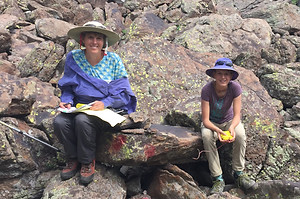

What are UFBs
About UFB
About Pikas

American pikas are small furry mammals, related to rabbits but closer in size to a large hamster. They live high in the mountains in rock fields. They are well-adapted to cold weather and don’t hibernate in the winter. Instead, in the summer they harvest grass and other plants and stack them into huge piles called haystacks to dry out. They take dried plant matter into their tunnels and eat it all winter. They are well-adapted to staying warm, but aren’t as good at staying cool, so there is concern they will be impacted by our warming climate.
Photo credit: National Wildlife Federation
Steamboat Forest Service
Pika Project
About the Project
The Steamboat Forest Service has been tracking temperatures in scree fields (pika habitat) for over 10 years. They put small iButton trackers, about the size of a nickel but a ¼ inch thick, under rocks in the scree fields. The iButtons record temperature 6 times a day, year round. The data allows the Forest Service to track how long the snowpack lasts and how hot it gets in the summer. They pair this data with whether there was any signs of pika activity observed by the researchers who change out the iButton to try to correlate pika occupancy to temperature changes.

What We Do

We started helping the Steamboat Forest Service in the summer of 2017 by hiking into high altitude, remote locations to change out iButtons and record pika occupancy. We also helped with amphibian surveys, which involved rubbing frogs bellies with q-tips to test for a fungus. We have since taken on the pika project and have continued doing it every year since. In 2019 we added a new part to the study: collecting pika poop so it can be tested for DNA and stress. We have continued with this project and as of 2021 we are still going into the field every year. This is some of my favorite volunteer work because all the pika sites are in the beautiful mountains around Steamboat Springs and it is a great excuse to go for a hike every day.
In the field with Chris Ray
About Her Project
Chris Ray, a researcher at CU Boulder, is an expert in pikas. She has been studying pikas for years and is instrumental in analyzing the Steamboat Forest Service Pika Project's data. Her pika studies are mostly focused on their connection to the Rocky Mountain water supply. She believes pika survival is linked to snow and ice under the rocks that lasts late into the summer - the same water that the Front Range relies on. She studies pikas by capturing them and giving them ear tags so she can track them, as well as taking fur, scat samples to test for stress and DNA.

What We Did

We spent a day in the field with Chris Ray in the fall of 2018 learning about her research and ways that we can help improve the Steamboat Forest Service’s study data. While we were in the field with her, she trapped several pikas and took blood and fur samples. After which, we helped release them back into their scree fields. Releasing a pika is the cutest thing, but it’s also a little tricky. After Chris finished processing a pika, she handed it to one of us in a mesh bag and we carried it back to where it was captured. We would open the bag and make sure their ear tags did not get caught. The pika would often sit for a moment, then suddenly dash out and vanish and I would just catch a glimpse as they disappeared under a rock.